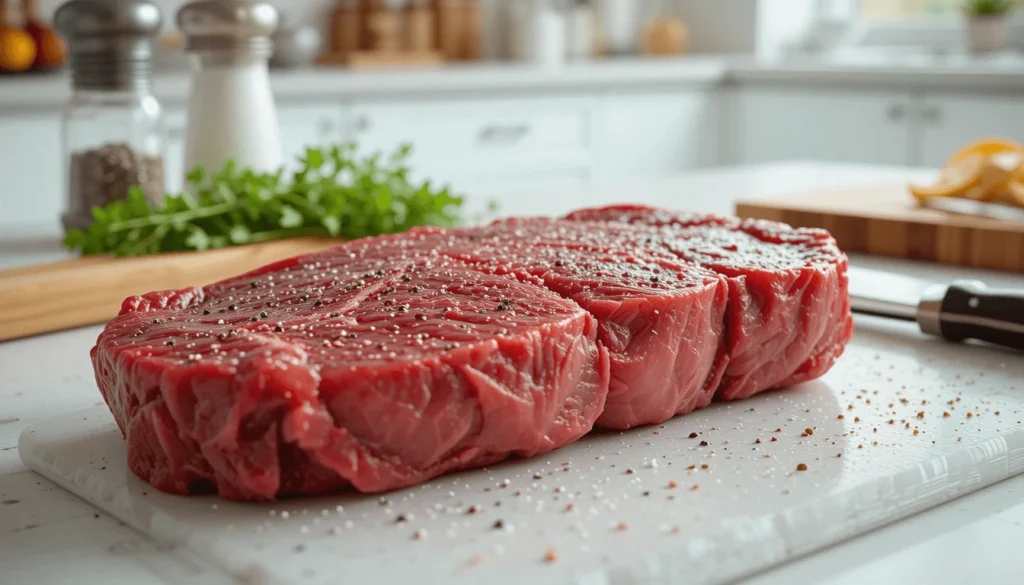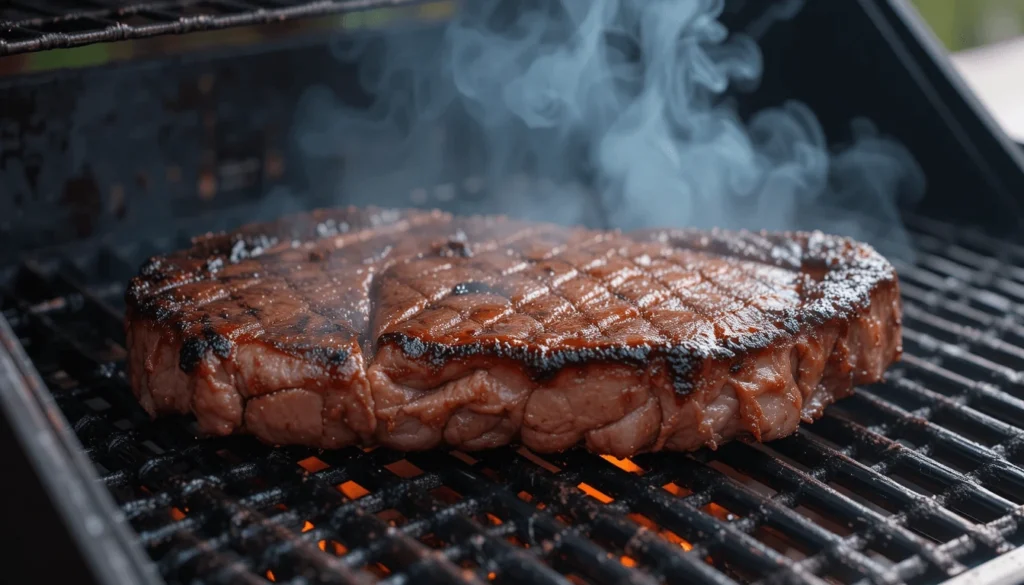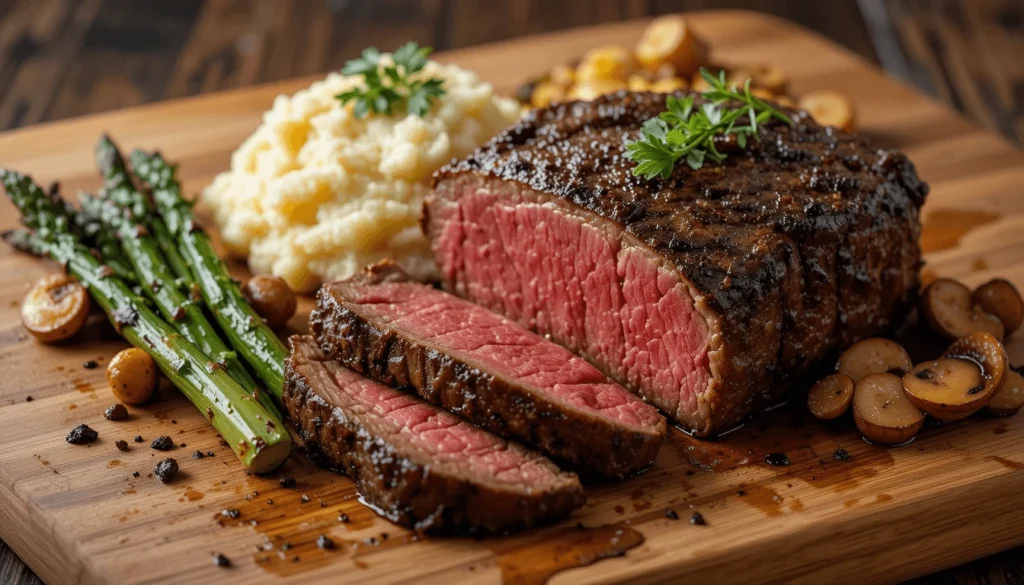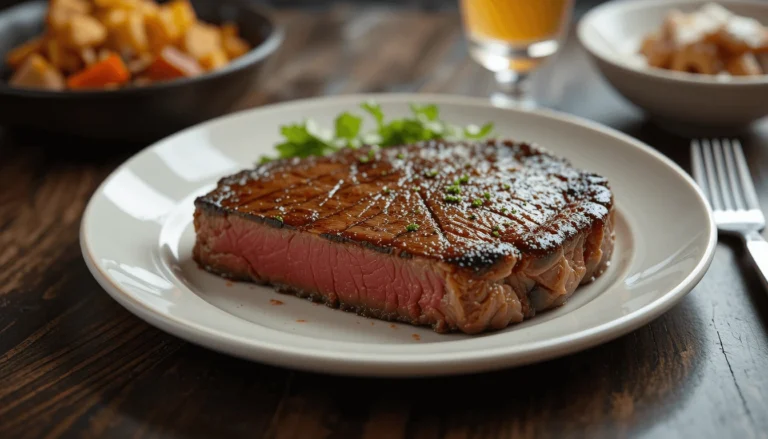Ribeye steak is one of the most beloved cuts of beef, renowned for its rich marbling, tender texture, and bold, beefy flavor. Whether you’re a seasoned chef or a home cook, understanding how to prepare and cook cut of beef to perfection can elevate your meals to a steakhouse-quality experience. In this ultimate guide, we will cover everything from selecting the best ribeye steak to the best methods of cooking, seasoning, and pairing it with perfect sides.
This comprehensive guide will provide you with the knowledge and techniques you need to master cooking ribeye steak, so you can impress your friends and family with every bite.
Table of Contents
Table of Contents
Introduction: How to Cook the Perfect Ribeye Steak
If you’ve ever had the pleasure of sinking your teeth into a perfectly cooked ribeye steak, you already know that there’s truly nothing quite like it. The moment you cut through the crispy, charred crust, revealing the tender, juicy meat within, you’re greeted with a burst of rich, savory flavors that dance across your taste buds. Ribeye steak has long been revered by steak enthusiasts as one of the most flavorful and indulgent cuts of beef. With its marbled fat and buttery texture, it’s a steak lover’s dream come true.
However, achieving this level of perfection in your own kitchen can be a challenge. Cooking a ribeye steak that rivals those from high-end steakhouses requires a combination of the right techniques, the best equipment, and a bit of culinary finesse. Whether you’re grilling, pan-searing, or even broiling, mastering the art of cooking ribeye steak takes practice and attention to detail.
In this ultimate guide to cooking ribeye, we’ll walk you through every step of the process, ensuring that you have all the knowledge and tools you need to prepare perfectly cooked cut of beef every single time. From selecting the best ribeye to the ideal cooking methods and flavor-enhancing marinades, we’ve got you covered.
In this article, we will explore:
- The best methods to cook steak: Whether you’re a fan of grilling, pan-searing, or broiling, we’ll provide you with clear, easy-to-follow instructions to cook your ribeye steak to the perfect level of doneness.
- How to choose the perfect ribeye: Not all ribeye steaks are created equal. We’ll guide you on how to pick the best ribeye cut based on marbling, aging, and quality to ensure a steak that’s both flavorful and tender.
- Ribeye steak cooking tips: The devil is in the details. With these expert cooking tips, you’ll learn how to handle your ribeye steak, control the cooking process, and avoid common mistakes that can lead to overcooked or under-seasoned meat.
- The best seasonings and marinades for ribeye steak: While ribeye is a flavorful cut on its own, adding the right seasonings and marinades can enhance the natural taste even further. From simple salt and pepper to complex spice rubs and marinades, we’ll share the best flavor combinations.
- How to pair ribeye steak with complementary sides and sauces: A cut of beef is only as good as the sides that accompany it. Learn what vegetables, potatoes, and sauces will balance out the richness of your steak and elevate your meal to a new level.
By the time you finish reading this guide, you’ll be able to cook ribeye steak like a professional chef, impressing your family and guests with every perfectly cooked steak. Whether you’re preparing an intimate dinner for two or hosting a backyard barbecue, you’ll have all the techniques and tips to achieve steakhouse-quality results in your very own kitchen.
So, let’s dive in and explore the world of ribeye steak – from selecting the right cut to cooking it to perfection and pairing it with the perfect sides and sauces. Ready to become a ribeye master? Let’s get started!

Understanding Ribeye Steak – What Makes It Special
What is Ribeye Steak?
cut of beefcomes from the rib section of the cow, specifically from ribs 6 through 12. This cut is well-known for its significant marbling of fat throughout the meat. This marbling, often seen as small streaks of fat within the muscle, is essential for the flavor and tenderness of the steak. The fat melts as the steak cooks, infusing the meat with a rich, juicy flavor.
The ribeye is also a relatively tender cut compared to other beef cuts, thanks to the fact that it comes from the cow’s least worked muscle. This makes it perfect for quick cooking methods such as grilling, pan-searing, or broiling.
Why Ribeye?
Ribeye is often favored over other cuts like sirloin or filet mignon because of its fat content. Fat equals flavor, and the ribeye has plenty of it. It strikes a balance between tenderness and rich beefy flavor, making it a favorite for steak lovers.
Not to mention, ribeye steak’s fat content provides the perfect texture when cooked correctly, offering a juicy bite every time. Whether you prefer your steak rare or well-done, ribeye tends to hold up well across all cooking preferences.
Selecting the Perfect Ribeye Steak
Fresh vs. Aged Ribeye – Which One to Pick?
When selecting ribeye steak, you’ll encounter two main types: fresh and aged. Fresh ribeye is a relatively straightforward option, usually sold at most supermarkets and butchers. However, aged ribeye, particularly dry-aged, has a unique, enhanced flavor profile that comes from the aging process. Dry aging allows the steak to concentrate its flavors, making it more intense and complex.
While fresh ribeye offers a more classic flavor, dry-aged ribeye provides a richer, almost nutty taste. If you’re looking for a more luxurious experience, dry-aged ribeye is worth the extra cost.
Understanding Marbling
Marbling refers to the visible fat streaks in the meat. It’s one of the most important factors in choosing a good ribeye steak. The higher the marbling, the more flavorful and tender the steak will be. Ribeye steaks with lots of marbling have better flavor because the fat melts as the steak cooks, ensuring that each bite is juicy and rich.
When shopping for ribeye steak, look for cuts that have consistent marbling throughout the meat. The fat should be white and spread evenly, not clumpy or in large chunks.

Best Ribeye Steak Cooking Methods
Grilling Ribeye Steak to Perfection
, pan-seared ribeye steak is one of the most popular methods, and for good reason. Grilling imparts a smoky flavor while allowing the fat to melt away, giving the steak a delicious charred crust. Here’s how to grill the perfect ribeye:
- Preheat the Grill: Set your grill to medium-high heat, allowing it to get very hot.
- Season the Steak: Lightly oil the steak and season generously with salt and pepper. You can also add garlic powder or your favorite seasoning mix.
- Grill the Steak: Place the ribeye steak on the grill. Grill for about 4-5 minutes per side for medium-rare, depending on the thickness of the steak.
- Check for Doneness: Use a meat thermometer to ensure your steak reaches the desired temperature. For medium-rare, aim for 130°F (54°C).
- Rest the Steak: Let the steak rest for about 5 minutes before cutting to retain juices.
Pan-Seared Ribeye – A Steakhouse Favorite
If you don’t have access to a grill, pan-searing is an excellent alternative. This method allows you to get a nice crust on the steak while keeping the inside tender and juicy. Here’s how to pan-sear your ribeye:
- Preheat the Pan: Heat a cast-iron skillet over high heat for a few minutes.
- Season the Steak: Season your ribeye steak with salt, pepper, and other spices to your liking.
- Sear the Steak: Place the steak in the hot pan and cook for 4-5 minutes on each side, depending on thickness.
- Add Butter: After flipping the steak, add a tablespoon of butter to the pan along with garlic and fresh thyme. Baste the steak with the melted butter for extra flavor.
- Rest the Steak: Let the steak rest before slicing to allow the juices to redistribute.
Ribeye Steak Cooking Times and Temperatures
How Long to Cook Ribeye Steak Based on Thickness
Cooking time for ribeye steak will depend on the thickness of the cut. A standard 1-inch thick ribeye typically takes:
- Rare: 4-5 minutes per side
- Medium-rare: 5-6 minutes per side
- Medium: 6-7 minutes per side
- Well-done: 8-9 minutes per side
Using a Meat Thermometer
A meat thermometer is one of the best tools for cooking cut of beef to perfection. Here are the recommended temperatures for different doneness levels:
- Rare: 120-125°F (49-52°C)
- Medium-rare: 130-135°F (54-57°C)
- Medium: 140-145°F (60-63°C)
- Medium-well: 150-155°F (66-68°C)
- Well-done: 160°F+ (71°C+)
Ensure that you insert the thermometer into the thickest part of the steak for the most accurate reading.
Ribeye Steak Seasoning and Marinades
Simple Seasoning for Maximum Flavor
For cut of beef, sometimes less is more. The key to enhancing the natural beef flavor lies in simple seasoning. A classic combination includes:
- Salt: Use kosher or sea salt for a crunchy texture.
- Pepper: Freshly cracked black pepper adds a mild heat.
- Garlic Powder: Adds depth and savory flavor.
You can also experiment with steak rubs, including thyme, rosemary, and smoked paprika, to add more complexity to the flavor.
Marinades to Elevate Your Ribeye Steak
While ribeye doesn’t need much seasoning, marinades can enhance its flavor and tenderize the meat. Consider these options:
- Garlic and Herb Marinade: Combine olive oil, minced garlic, fresh rosemary, thyme, and lemon zest. Let the steak marinate for 2-4 hours.
- Balsamic Vinegar Marinade: Mix balsamic vinegar, olive oil, Dijon mustard, garlic, and honey for a slightly tangy and sweet marinade.
- Soy Sauce and Brown Sugar Marinade: A marinade made from soy sauce, brown sugar, and garlic gives the ribeye a savory and slightly sweet glaze.
Marinating the steak for at least 30 minutes, or up to 24 hours, will allow the flavors to soak into the meat.
Ribeye Steak Side Dishes That Pair Perfectly
Classic Steakhouse Sides – Potatoes, Veggies, and More
cut of beef pairs beautifully with a variety of side dishes. Classic steakhouse sides include:
- Mashed Potatoes: Creamy mashed potatoes with butter and cream are the ultimate pairing for steak.
- Grilled Asparagus: The smoky flavor of grilled asparagus complements the richness of ribeye steak.
- Sautéed Mushrooms: Mushrooms sautéed in butter with garlic are a perfect match for the savory flavor of ribeye.
Fresh Salads and Salsas to Balance Richness
To balance the richness of the ribeye, try serving it with a fresh salad or salsa. A light and refreshing Greek Salad with cucumbers, tomatoes, feta cheese, and olives provides a nice contrast to the steak. Similarly, a Tomato Salsa or Citrus Avocado Salad can add bright, fresh flavors to your meal.

How to Rest and Slice Ribeye Steak
Why Resting Your Ribeye Steak is Crucial
Resting the steak is an essential step in the cooking process. After cooking, let your ribeye steak rest for 5-10 minutes. During this time, the juices redistribute throughout the meat, ensuring it’s juicy and tender when you slice into it.
Properly Slicing Your Ribeye Steak
Once your cut of beef has rested, it’s time to slice it. Always slice against the grain to ensure tenderness. Cutting along the muscle fibers rather than with them ensures that each bite is easy to chew and packed with flavor.
https://www.beefitswhatsfordinner.com/
Common Mistakes to Avoid When Cooking Ribeye Steak
Overcooking Your Ribeye – How to Avoid It
One of the most common mistakes when cooking ribeye steak is overcooking it. Always use a meat thermometer to check for doneness, and be sure to rest the steak before slicing.
Choosing the Wrong Pan or Grill
Make sure you use the right equipment for the job. Cast-iron skillets or heavy-duty grills are ideal for achieving a good sear and even cooking. Avoid non-stick pans, as they don’t achieve the same results when cooking steak.
FAQs About Ribeye Steak Cooking
- What is the Best Way to Cook Ribeye Steak?
The best method depends on your preferences, but grilling and pan-searing are both excellent options for ribeye. - Can I Cook Ribeye Steak in the Oven?
Yes, ribeye steak can be cooked in the oven by broiling it or searing it on the stove and finishing it in the oven. - What is the Best Temperature to Cook Ribeye Steak?
The ideal temperature for cooking ribeye steak depends on the level of doneness. For medium-rare, aim for 130-135°F (54-57°C). - How Do I Know When My Ribeye Steak is Done?
A meat thermometer is the best tool for checking doneness. Insert it into the thickest part of the steak to ensure it’s cooked to your preference. - Can Ribeye Steak Be Cooked on a Cast-Iron Skillet?
Yes! A cast-iron skillet is perfect for searing ribeye steak, as it helps create a crisp, caramelized crust. - How Do I Store Leftover Ribeye Steak?
Leftover ribeye steak can be stored in the fridge for 3-4 days. Be sure to store it in an airtight container to retain its flavor and moisture.
Conclusion: Master the Art of Cooking Ribeye Steak and Create Steakhouse Perfection at Home
In conclusion, cooking the perfect ribeye steak is truly an art form, one that requires both knowledge and skill. It’s not just about picking up any steak from the butcher and throwing it on the grill; it’s about understanding the intricacies of the cut, choosing the best quality ribeye, and using the right cooking methods to bring out its full potential. Whether you’re grilling, pan-searing, or baking, each cooking method brings out different aspects of the steak’s flavor and texture, and knowing how to use them effectively is key to getting the perfect ribeye every time.
Selecting the right ribeye steak is crucial for achieving a tender, juicy, and flavorful meal. The best ribeye cuts are those with a good amount of marbling, which ensures a melt-in-your-mouth texture and deep, rich flavors. While fresh ribeye is widely available, dry-aged ribeye brings an entirely different level of depth to your steak, with enhanced flavors and tenderness that can truly elevate your cooking game. Be sure to choose cuts with fine marbling and consider how aging and the thickness of the steak can affect your cooking time and method.
Once you’ve selected your ribeye, the next step is mastering the cooking techniques. Grilling ribeye steak is a classic method that gives the steak that irresistible smoky flavor, while pan-searing provides a beautifully crisp crust with a juicy interior. For those who prefer a more hands-off approach, oven-baking is an excellent way to achieve evenly cooked steak with less attention needed. Each method requires a different set of techniques and timing, but with a little practice, you’ll be able to cook ribeye steak to perfection every time.
Beyond just the steak itself, seasonings and marinades play a significant role in elevating the flavors of the ribeye. The beauty of ribeye is that its natural flavor is rich and bold, so a simple seasoning of salt and pepper may be all you need. However, if you’re looking to experiment, marinades that feature ingredients like garlic, herbs, soy sauce, and balsamic vinegar can add new dimensions to your steak’s flavor. Whether you’re looking for a savory, herby marinade or something with a bit of sweetness, the right combination of flavors can truly make your ribeye steak shine.
Pairing your ribeye steak with the right sides and sauces is essential for creating a complete, balanced meal. Classic sides like mashed potatoes, grilled vegetables, and fresh salads perfectly complement the richness of the steak, offering contrast in both texture and flavor. Consider adding a creamy béarnaise sauce or a rich blue cheese butter to elevate your steak experience. The sides you choose will enhance the natural beefiness of the ribeye, allowing you to enjoy every bite to the fullest.
One of the most important steps in cooking ribeye steak is resting the meat after cooking. It may be tempting to cut into your steak immediately, but letting it rest for a few minutes allows the juices to redistribute throughout the meat, ensuring each bite is as juicy and tender as possible. This simple step can make all the difference between a good steak and an extraordinary one.
Cooking ribeye steak at home doesn’t have to be intimidating. With the right tools, the perfect ribeye cut, and a little bit of practice, you can create a steakhouse-quality meal without leaving your kitchen. Whether you’re a seasoned chef or a beginner cook, the methods and tips in this guide will help you achieve restaurant-quality ribeye steaks that will impress your guests and make every meal feel special.
Remember, cooking the perfect ribeye is all about mastering the basics: understanding the meat, choosing the right cooking technique, and finishing with the perfect seasoning and sides. With these fundamentals in your toolkit, you’ll have everything you need to prepare a delicious, satisfying meal that brings out the best in this world-class cut of beef.
So, fire up that grill, preheat your pan, or set your oven to the perfect temperature. Your perfect ribeye steak awaits – and with these tips in hand, you’ll be cooking like a professional in no time. Enjoy the process, savor every bite, and most importantly, happy cooking!
Print
Ultimate Guide to Cooking Ribeye Steak – Perfect Techniques and Tips
Master the art of cooking ribeye steak with this ultimate guide. Learn the best methods, tips, and seasoning options to cook a steakhouse-quality ribeye at home!
- Total Time: 20-30 minutes
- Yield: 2 servings (adjust based on the number of steaks)
Ingredients
Ribeye steak (1-2 steaks, 1-inch thickness recommended)
Kosher salt (to taste)
Freshly cracked black pepper (to taste)
Olive oil (for grilling or pan-searing)
Garlic powder (optional)
Fresh herbs like thyme and rosemary (for basting, optional)
Butter (for pan-searing, optional)
Instructions
Prepare the Steak: Remove the ribeye steak from the fridge about 30 minutes before cooking to bring it to room temperature. This ensures more even cooking.
Season the Steak: Lightly oil the steak and season generously with kosher salt, freshly cracked black pepper, and optional garlic powder or other seasoning of choice.
Choose Your Cooking Method:
Grilling: Preheat the grill to medium-high heat. Grill the steak for 4-5 minutes per side for medium-rare, or adjust depending on your desired doneness.
Pan-searing: Preheat a cast-iron skillet over high heat. Add a little oil and sear the steak for 4-5 minutes on each side, then add butter and fresh herbs to baste. Rest the steak for 5 minutes before slicing.
Check Doneness: Use a meat thermometer to check internal temperature. Aim for 130°F (54°C) for medium-rare.
Rest the Steak: After cooking, allow the steak to rest for 5-10 minutes to ensure it remains juicy.
Slice and Serve: Slice against the grain and serve with your favorite sides and sauces.
Notes
For best results, use a meat thermometer to avoid overcooking.
Dry-aged ribeye steaks offer enhanced flavors but may come at a higher cost.
Pair the steak with classic sides like mashed potatoes, grilled asparagus, or sautéed mushrooms for the perfect meal.
- Prep Time: 10 minutes (plus 30 minutes to bring the steak to room temperature)
- Cook Time: 10-15 minutes (depending on the cooking method and steak thickness)
- Category: Main Course
- Method: Grilling, Pan-Searing
- Cuisine: American
- Diet: Gluten Free
Keywords: Ribeye steak, how to cook ribeye, grilling ribeye, pan-searing ribeye, steak seasoning, steak marinade, perfect steak, beef recipes, steakhouse at home, ribeye cooking tips.


